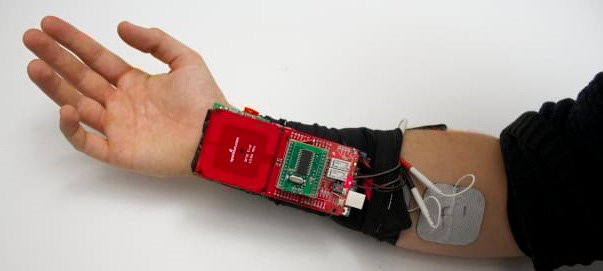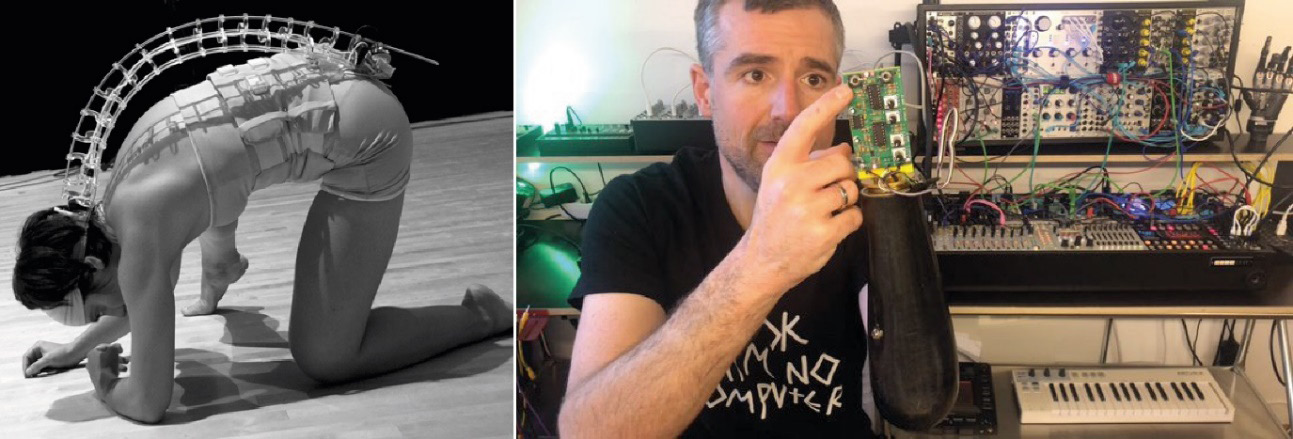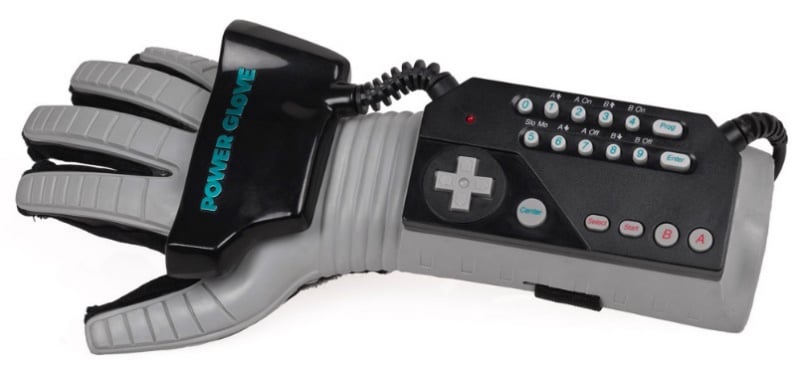Exciting ideas, concepts, and projects to motivate
So far, we’ve looked at the history of, and what is current in, the wearable world. What about when devices become smaller, making them easily portable, lowering their energy needs, and smarter? Here are a few projects and products to help you to feel inspired when thinking about your wearable designs.
Extension of the body
The body is a dynamic system, and we can create enhancements for this dynamic system when we augment it with our wearable technology. We can look to extend the body and use our senses to create new and unusual relationships with our surroundings.
We can explore these technologies to understand how our bodies interact within spaces or with each other. The body can be extended through mechanical, gestural, and sensory qualities. These shifts in our perspective can help us acquire new ways of thinking and developing body-technology systems. What can we design to enhance our gestural engagement with the environment around us?
What if we had smart sneakers to analyze how you walk or smart gloves to help your golf swing? The Under Armour Flow Velociti Wind will track your running and try to improve it. There are gloves that read grip pressure to provide audio and visual feedback to help your golf game. The Movano ring provides you with sensor data for your heart rate, temperature, and more to help you get a better night’s sleep.
Pedro Lopes is researching electrical muscle stimulation, as shown in Figure 1.17, through components and sensors. More of his research can be found online at http://plopes.org/:

Figure 1.17 – Pedro Lopes: Electrical Muscle Stimulation
Electrical muscle stimulation is used to nudge a person into certain hand gestures. This can be a squeeze, drop, shake, and so on:

Figure 1.18 – External spine with a touch-sensitive ribcage (left) and Bertolt Meyer (right)
Researchers in Canada have designed prosthetic musical instruments. Figure 1.18 shows an external spine with a touch-sensitive rib cage. It creates music in response to body gestures. Photo credit: Vanessa Yaremchuk. Instrument conception and design are credited to Joseph Malloch and Ian Hattwick of the Input Devices and Music Interaction Lab (IDMIL) at McGill University. See http://www-new.idmil.org/ for more information.
Musician Bertolt Meyer (Figure 1.18) has a prosthetic arm and uses it to control his synthesizer and music using his mind. He plugs it directly into the synth to control the music by thinking about it.
The Ivy health tracker, is a bracelet that monitors your heart rate, respiratory rate, cardiac coherence, and physical and mental activity. It has a non-typical form factor, which is why it’s included here. It is designed for women’s health, and they are currently working on a device for post-natal depression.
The Viscero ECG Vest (Design Partners, 2021) Ireland-based Design Partners is a wearable ECG device that looks like the iconic plain white t-shirt shown in Figure 1.19. Designed to do away with the current large, uncomfortable monitors, Viscero is a white vest you wear underneath your clothing. Viscero is as easy to use as wearing a t-shirt.
The body-hugging vest comes with dry electrodes integrated into the t-shirt’s design. These are placed in specific areas to accurately capture medical data, while the data itself is sent to a compact smart wearable device that attaches to the side of the t-shirt, right above the pocket:

Figure 1.19 – Viscero ECG device (left) and MedBot concept (right)
The MedBot smartwatch concept was designed by Batyrkhan Bayaliev (permission and photo: https://www.behance.net/bayalievbaae07) as a health wearable, as shown in Figure 1.19.The smartwatch is equipped with a blood pressure sensor that will take readings when required and can also be utilized as a way to monitor additional health metrics.
The device also features storage space inside for a person’s medication and will remind them when it’s time to take their next dose. It also reminds users when it’s time to take their pills. This explores the intersection of health and smart technology. This is currently a concept design.
1989, in the era of Nintendo-mania, toymaker giant Mattel unleashed a bold technological experiment to an eager public known as the Nintendo Power Glove, as shown here:

Figure 1.20 – Power Glove (photograph by Evan-Amos-Own work, Public Domain, https://commons.wikimedia.org/w/index.php?curid=16915852)
This was the first video game controller that could use hand gestures. However, the product was a critical failure, with terrible gameplay. Three decades later, dedicated fans continue to repurpose the Power Glove for art pieces, hacking projects, electronic music, and more. Although not “current,” it is certainly a great start to making a wearable design.
Meta unveiled a prototype haptic feedback glove as a prototype, as shown in Figure 1.21. It is planned to be put into production and has 15 actuators that have contact with skin. These actuators deliver physical sensations through stiffening, loosening, and fabricating resistance:

Figure 1.21 – Meta haptic VR glove, Meta Reality Labs (left) and Wire Sensing glove (right) (Photo Credit: Purdue University/Rebecca McElhoe)
This allows you to feel VR objects. Another glove concept is one where the fingertips of a wireless voltage detection glove illuminate when the wearer’s hand approaches a live cable. The gloves are powered wirelessly through a flexible, silk-based coil sewn on the textile and are laundry resistant.
There are even gloves that help with fruit picking. Rafael V. Aroca et al. (2013) propose a system of using gloves for non-typical applications. The gloves have sensors on them and by pointing or touching the fruit, it can analyze and measure their attributes.
Now that we’ve looked at some of the other ways wearables are being used and made, you may want to look at Jennifer Crupi’s work for inspiration: https://www.jennifercrupi.com/work. She is a metalsmith who creates objects that fit the body in an unusual way.

